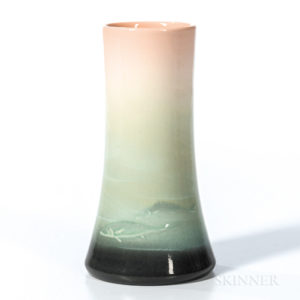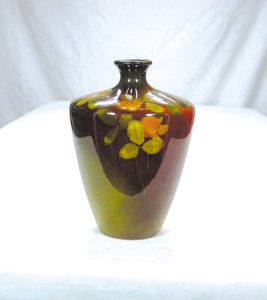 By Anne Gilbert
By Anne Gilbert So you’ve just discovered a small pottery vase not only signed “Rookwood,” but with an artist’s signature at a garage sale! And, for this great discovery you paid $90. A lot of money at a garage sale but couldn’t it be worth thousands? Once home you excitedly grab your Handy-Dandy Price Guide. Sure enough the artist and a similar piece are listed for $200. Closer examination shows the piece is a rather dull, brown matte glaze. You paid for the name and a signature, not quality.
The Rookwood Pottery, established in Cincinnati, Ohio in 1879 by Maria Longworth Nicholas Storer, was at the forefront of a growing American Art pottery movement. Initially art pottery was made by creative craftsmen as an attempt to fight against mass produced ceramics. By banding together in studios the artists-potters created objects of art priced for the masses. Rookwood used an assembly line technique for standard shapes of inexpensive mass produced lines. However, museum quality pieces were created by individual designers early on. It is these pieces that command thousands of dollars today.
Names and designs are important. Among the Rookwood artists to look for are Kataro Shiraymadani (1865-1948) who gave the subject matter of Japanese art to American pottery. Also considered one of Rookwood’s finest decorators was Albert Valentien who specialized in floral motifs. Another artist, Elizabeth Lingenfelter working in 1910 began using the newly popular lighter colors. Quality earlier pieces are always higher priced. For instance, though Shiraymadani worked into the 1940s prices are lower than even the 1920s. These days quality designed pieces can fetch high thousands of dollars.
CLUES: Art pottery has been faked since the 1970s, when there was a revival of interest among collectors. Trained potters from Japan and Italy have been faking the early Rookwood tiger eye glazes. While the clay is soft they stamp in the proper marks, including artists initials. often, new decorations are even applied over old pieces. Other problems for collectors can come from the many vases turned into lamps. Don’t let anyone try to palm off a Rookwood style vase-lamp on you unless it has the trademark, “Rookwood Pottery” stamped into the metal base. if you know your Rookwood, it is possible that you have a vase-lamp that had been privately taken to a shop for drilling, had a paper label, now long gone. Research, research.
 The Rookwood Pottery outlasted its competitors (1880-1967). The popular, older, tiger-eye crystalline glaze was revived in the 1920s as a shimmering yellow or green glaze. The glaze was formed by the crystallization of chrome oxide crystals in the glaze during the cooling process. it continued to be made up to 1950.
The Rookwood Pottery outlasted its competitors (1880-1967). The popular, older, tiger-eye crystalline glaze was revived in the 1920s as a shimmering yellow or green glaze. The glaze was formed by the crystallization of chrome oxide crystals in the glaze during the cooling process. it continued to be made up to 1950. Over the years there have been many marks. One of the most informative guides to marks and glazes for Rookwood and other American Art Pottery is “Kovel’s American Art Pottery, Crown Publishers, 1993, by Ralph and Terry Kovel.
Since it was the fine glazes that were partially responsible for the success of Rookwood, the loss of their best technicians in the late 1940s speeded up the decline in quality. The decorative pieces made to sell inexpensively in gift shops weren’t successful. Among the items you may come across are glazed ashtrays, unglazed bisque for amateur hobbyists in the form of vases, paperweights and bookends. However, since they have a Rookwood name people pay up to $200 or more.
Photo caption (1) Rookwood vase signed Olga Genova Reed- c. 1910. from Kilpatrick On line
Photo caption: Rookwood vase designed by Lenore Asburg — “Swimming fish.”















Follow Us